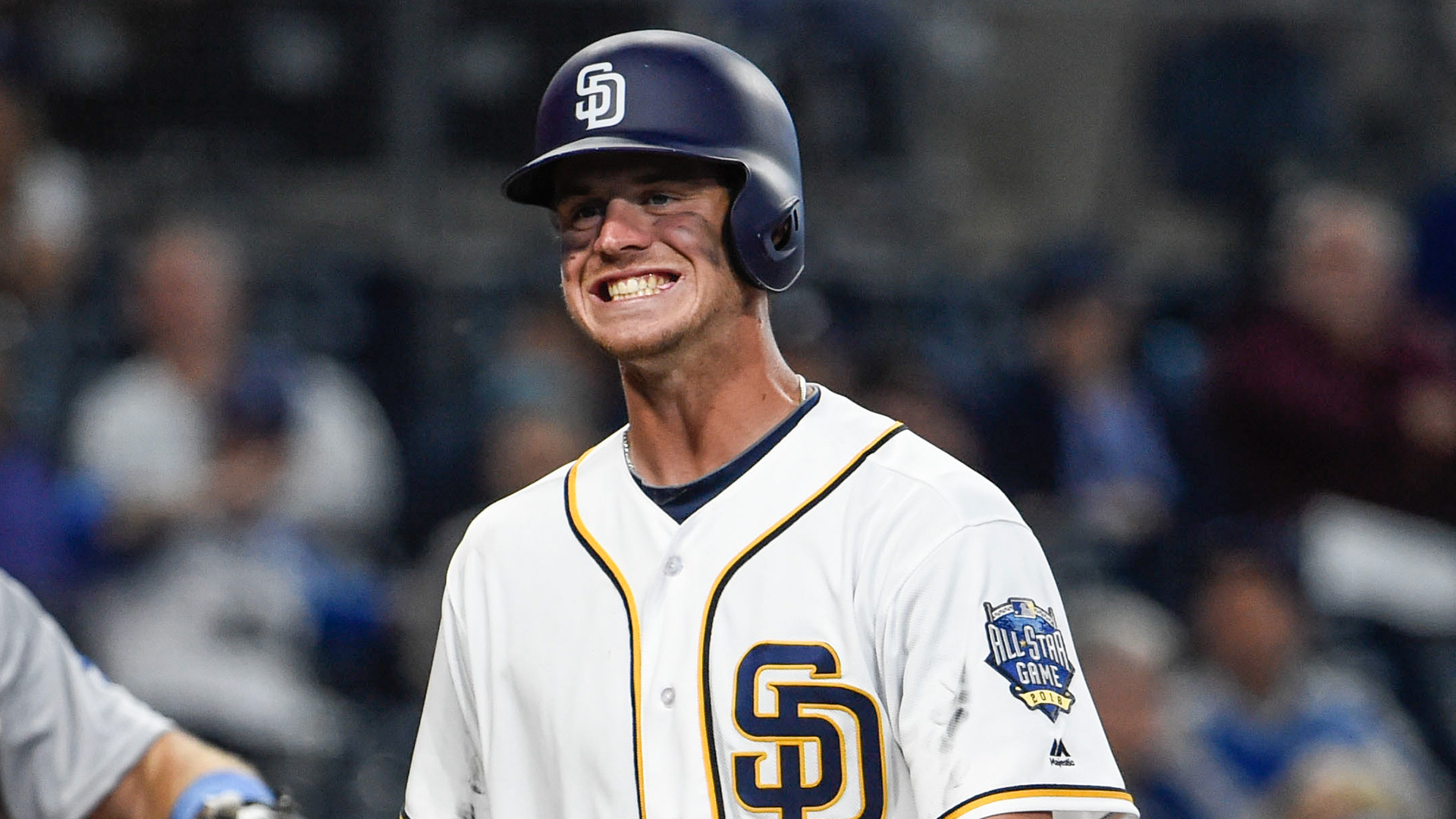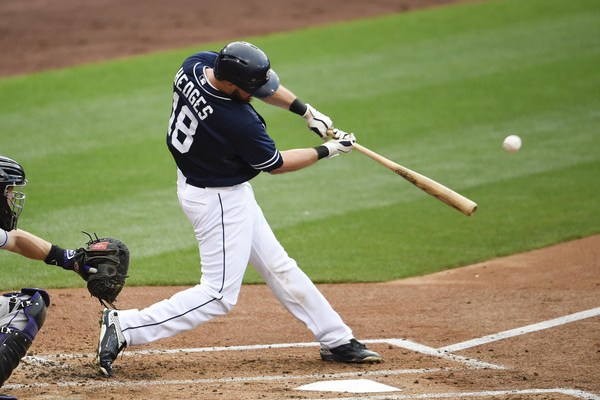The Padres’ Plate Discipline Problem


Just over one month into the 2017 season, the San Diego Padres sit at 12-17 through the team’s first 29 games. Going into the season, most knew the Padres would be largely non-competitive. While there has been some surprise wins for the Friars, that expectation has largely come to fruition. However, the Padres have played a much different game than what was expected.
Everyone had a good idea that the Padres pitching staff would be something of a dumpster fire in 2017. By comparison, there was at least some chance that the offense could impress, with several young hitters with lots of potential filling out the lineup on a nightly basis. So far, neither of those things has happened. The Padres pitching staff has been surprisingly resilient, even impressive at times, while the Padres offense has seemingly had more downs than ups.
The Padres impressive start to the season on the mound definitely deserves a more in-depth look at a later time, but the focus here should be on the offense, and the shortcomings that have come to the forefront over the first sixth of the season.
Earlier in the week, I took a look at Wil Myers early season results and how his change in approach has led him to some early season success. You should check out that piece as well, but in sum, Myers is driving the ball more and making more frequent hard contact than he did last year, while experiencing a slight uptick in his strikeout rate and a rather significant decline in his walk rate. In fact, Wil Myers has the second worst walk rate in all of baseball among qualified players, behind only the free-swinging Yuli Gurriel and directly ahead of teammate, Hunter Renfroe. To this point, this new strategy seems to be working out for Myers, and he appears to be a completely different hitter. However, at the team level, this change in approach may not bode well for the Padres long-term.
As a team, the Padres have quickly found themselves at the very bottom of the league in several plate discipline measures. Let’s start off with walk rate. In total, the Padres find themselves in the bottom five of the entire league in walk rate, as they are walking in only 7.1 percent of all plate appearances. Moving on from walk rate, the Padres also rank in the bottom five in terms of strikeout rate, this time at third worst in the league at 24.9 percent, trailing only the Tampa Bay Rays and Milwaukee Brewers, two teams with a lot of free swinging players.
So the Padres aren’t walking much and they are striking out more than almost any other team. Not really a recipe for sustainable success, as the Padres rank 28th in all of baseball with a team wRC+ of just 78. Let’s dive a little deeper by looking at plate discipline numbers for the Padres as a team. Over at Fangraphs.com, which might be the best website out there for statistical baseball content, just about every stat imaginable is tracked, including plate discipline numbers.
Before we delve into those numbers, let’s lay the groundwork for what these stats measure. The plate discipline numbers at Fangraphs are split into nine separate stats, further split into groups measuring swings, contact, how many pitches a batter sees in the strike zone, first pitch strikes, and swinging strikes. Let’s start by focusing on a few of these stats, specifically on swings, including O-Swing% (percentage of swings on all pitches outside of the strike zone), Z-Swing% (percentage of swings on all pitches inside the strike zone), and Swing% (percentage of swings on all pitches).

As a team, the Padres currently have a 32.2 percent O-Swing rate as a team, which would be the worst in baseball if not for the lowly Royals and their 33.4 O-Swing percentage. Interestingly enough, the Padres team Z-Swing percentage shows an odd dichotomy, as the team ranks 17th in baseball with a 66.3 percent Z-Swing rate. So the Padres are swinging at more pitches outside of the zone than almost any other team, but not swinging as freely at pitches inside of the strike zone. This difference shows some serious pitch selection problems for the Padres, as batters are swinging at bad pitches and not swinging at good pitches. In the case of total Swing percentage, the bad outweighs the good, as the Padres have the fourth highest swing rate in all of baseball at 47.5 percent, with most of those swings apparently coming on pitches outside the strike zone.
Time to move on to the Padres contact numbers. On pitches outside of the strike zone, the Padres are making contact 62.1 percent of the time, good for 19th in baseball. Certainly not good, but at least slightly encouraging. However, the problems rear their head again when looking at contact on pitches inside the strike zone. Not only are the Padres not taking advantage of good pitches inside the strike zone, but they are also making contact on pitches inside the strike zone at a rate of just 82.9 percent, third worst in all of baseball. Total contact percentage on all pitches once again puts the Padres at the bottom of the pack, this time at 28th.
So as a team, the Padres are swinging at a lot of pitches outside of the zone, and failing to make a lot of contact on pitches inside of the zone. Once again, not a recipe for any sustainable offensive success. To this point, all these stats have shown problems in the Padres offense, but we have only reached the tip of the iceberg. Moving on to F-Strike% (percentage of first pitches that go for strikes), the Padres stand all alone as the worst team in baseball, taking 63.5 percent of first pitches for strikes. The Padres are getting themselves in a hole with first strikes and then swinging at bad pitches outside of the zone. This number certainly aligns with the Padres low contact numbers on balls inside the strike zone, as the team is too patient early in the count and too aggressive at the end of plate appearances.
Now, time for the final plate discipline stat to discuss, which is perhaps the most damning of all. SwStr% measures how often a hitter swings and misses at a pitch. You can probably guess where the Padres rank by this measure. While not dead last, the Padres have the second worst swinging strike rate at 11.8 percent, which is a truly unsustainable number. In sum, the Padres are falling behind in counts, swinging at bad pitches, not hitting good pitches, and swinging and missing at too many pitches. Being free swinging may not always be a bad thing, but it is with that kind of low contact number. If you summed up what a bad offense would look like, this is it. There’s obviously time to make adjustments and improve the offense, but if these trends continue, the Padres offense could be in for a rough season.

Editorial and Prospect Writer for East Village Times. Twenty-five years young, Patrick has lived in San Diego for his entire life and has been a Padres fan nearly as long. Patrick lives for baseball and is always looking to learn new things about the game he loves through advanced stats.